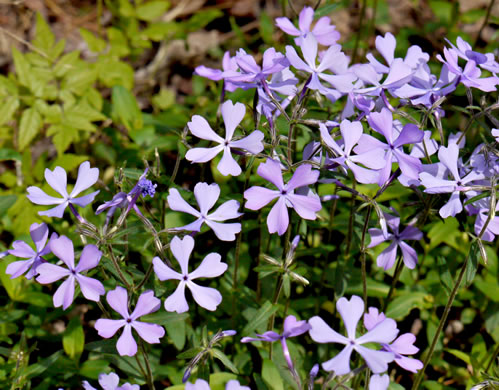Polemoniaceae
eastern blue phlox
Phlox divaricata
Synonyms
Phlox divaricata ssp. divaricata
Plant Type
Herbaceous Wildflower
Life Cycle
Perennial
Typical Size
0.5-1 ft. tall
1-1.5 ft. wide
Tolerant of
Drought
Inolerant of
Poorly Drained Soil, Direct Afternoon Sun
Propagation
By seed, By cutting, By division, By air-layering
Plant Propagation Notes
Seeds require cold moist stratification.
Plant Planting Notes
Provide about 2 ft spacing.
Plants/Diseases
Powdery mildew may be an issue in wetter conditions. Spider mites may be an issue in hot, dry conditions.
Wildlife Benefits
Nectar/pollen source for pollinating insects, Nectar source for hummingbirds
Leaves
Leaves opposite, elliptical to lanceolate with hairy/sticky surfaces.
Flowers
Blue to purple flowers that are fragrant with five petals flaring from a tube clustered in an umbel.
Fruit
Capsule.
Toxicity
No known toxicity.

USDA Hardiness Zones
3, 4, 5, 6, 7, 8
Light Exposure
Part Sun/Shade, Full Shade
Soil Moisture
Moist
Soil Drainage
Well-drained
Soil pH
Acidic (less than 6.0), Neutral (6.0-8.0)
Native in South Carolina?
Yes
Plant Native Habitat
Prefers circumneutral soils in deciduous forests.
Global Conservation Status (NatureServe)
Secure (G5)
Federal Conservation Status (USFWS)
Not Listed
Distribution Notes
Rare in the South Carolina coastal plain, sandhills, and piedmont. Absent from the mountains.
Subspecies
Phlox divaricata var. divaricata
Phlox divaricata var. laphamii



